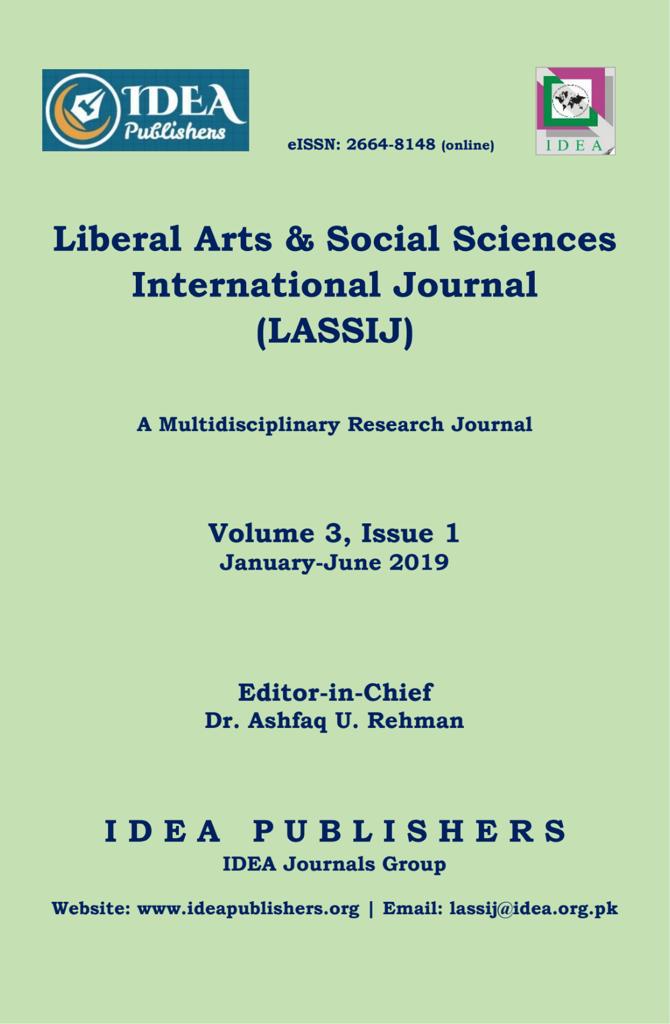SCO as a Passage to Regional Security: Future Developments and Opportunities for Pakistan
DOI:
https://doi.org/10.47264/idea.lassij/3.1.3Keywords:
SCO, Regional Security, Regional Cooperation, Economic Development, CPEC, Counter-terrorism CooperationAbstract
The Shanghai Cooperation Organization (SCO) is a pathway to promote regional security and has a strong commitment to counter security threats. The primary purpose of the organisation is to promote security, peace, and regional stability. Juxtapose SCO offers an opportunity for the member states to create direct security linkages in the region. First, the paper articulates the historical development of the SCO. Moreover, the paper evaluates SCO as a substantial pathway which is promoting the regional security effectively and how Pakistan, being a critical member state, is playing an active role in regional security. In addition, another goal is to determine how SCO member states enhance counter-terrorism cooperation at state levels as well as in the regional levels. The study shows that Pakistan supports SCO’s efforts for regional cooperation in counter-terrorism, drug trafficking and planned crimes. The paper concludes that regional security is an influential tool for further development of SCO. Finally, this paper briefly looks at the developmental programs like China-Pakistan Economic Corridor (CPEC) that how the changing patterns in world politics promotes regional security with special focus on Pakistan.
References
Abid, M. & Ashfaq, A. (2015). CPEC: Challenges and opportunities for Pakistan. Journal of Pakistan Vision, 16(2), 142-169.
Adnan, M. & Fatima, B. (2016). China-Pakistan Economic Corridor: A road to development and its challenges. South Asian Studies, 31(2), 241-253.
Akiner, S. (2010, June). The Shanghai Cooperation Organisation: A networking organisation for a networking world. Global Strategy Froum.
Bhadrakumar, M. (2007). The new ‘NATO of the East’ takes shape: The SCO and China, Russia, & US maneuvers. The Asia-Pacific Journal Japan Focus Volume, 5(8), 1-9.
Buzan, B., Buzan, B. G., Waever, O., W'ver, O., & Buzan, O. W. B. (2003). Regions and powers: The structure of international security (Vol. 91). Cambridge University Press. DOI: https://doi.org/10.1017/CBO9780511491252
Buzan, B., Waever, O., Waever, O., & De-Wilde, J. (1998). Security: A new framework for analysis: Lynne Rienner Publishers.
Chung, C. P. (2006). China and the institutionalization of the Shanghai Cooperation Organization. Problems of Post-Communism, 53(5), 3-14. DOI: https://doi.org/10.2753/PPC1075-8216530501
Fallon, T. (2015). The new silk road: Xi Jinping's grand strategy for Eurasia. American Foreign Policy Interests, 37(3), 140-147. DOI: https://doi.org/10.1080/10803920.2015.1056682
Fels, E. (2013). The Role of the SCO in Afghanistan. In Partners for stability (pp. 235-250). Nomos Verlagsgesellschaft MBH & Co. KG. DOI: https://doi.org/10.5771/9783845238777-235
Herd, G. P. & Kriendler, J. (2013). Understanding NATO in the 21st century: Alliance strategies, security and global governance: Routledge. DOI: https://doi.org/10.4324/9780203076002
Khamraev, F. (2004). NATO-SCO: Struggle against terrorism and/or for domination in Central Asia. Central Asia and the Caucasus, 2(26). Retrieved from, https://cyberleninka.ru/article/n/nato-sco-struggle-against-terrorism-and-or-for-domination-in-central-asia
Khatoon, A., Rahim, N., Ali, B. (2018). A historical perspective of Chaina's peaceful policies and its Rise as world economic power. Liberal Arts and Social Sciences International Journal (LASSIJ), 2(1), 65-74. https://doi.org/10.47264/idea.lassij/2.1.8 DOI: https://doi.org/10.47264/idea.lassij/2.1.8
Lanteigne, M. (2006). In Medias Res: The development of the Shanghai Cooperation Organization as a Security community. Pacific Affairs, 7(4), 605-622. DOI: https://doi.org/10.5509/2006794605
Mariani, B. (2013, October). China’s role and interests in Central Asia. Saferworld.
Matveeva, A. & Giustozzi, A. (2008). The SCO: a regional organisation in the making. Working Paper 39 - Presented by Regional and Global Axes of Conflict - Crisis States Research Centre.
Muzaffar, M., Yaseen, Z. & Rahim, N. (2017). Changing dynamics of global politics: Transition from unipolar to multipolar world. Liberal Arts and Social Sciences International Journal (LASSIJ), 1(1), 49-61. https://doi.org/10.47264/idea.lassij/1.1.6 DOI: https://doi.org/10.47264/idea.lassij/1.1.6
Idrees, M., Naazer, M. A., & Ashfaq, S. (2017). Conflicts and conflict management in SAARC: Assessing Challenges and the Way Forward. Liberal Arts and Social Sciences International Journal (LASSIJ), 1(2), 1-11. https://doi.org/10.47264/idea.lassij/2.1.1 DOI: https://doi.org/10.47264/idea.lassij/1.2.1
Oksuz, S. (2009). An emerging power house in Eurasian geopolitics: The Shanghai six+. Ege Academic Review, 9(2), 713-734. DOI: https://doi.org/10.21121/eab.2009219721
Qadir, M. I. & Rehman, S. U. (2016). Expansion of Shanghai Cooperation Organization (SCO) harbinger of regional peace and prosperity. Journal of Political Studies, 23(1), 117-132.
Rehman, A. U., Ashfaq, S., & Khan, T. M. (2018). Kargil operation and its effects on the civil-military relations in Pakista. Liberal Arts and Social Sciences International Journal (LASSIJ), 2(2), 10-21. https://doi.org/10.47264/idea.lassij/2.2.2 DOI: https://doi.org/10.47264/idea.lassij/2.2.2
Rehman, A. U., Rahman, B. & Ali, T. (2018). US war on terror: Portrayal through carcatures in the selected newspapers of Pakistan. Pakistan Journal of Criminology, 10(3), 41-63. http://www.pjcriminology.com/publications/us-war-on-terror-portrayal-through-caricatures-in-selected-newspapers-of-pakistan/
Rehman, A. U. Hakim, A. Khan, K. & Khan, I. U. (2018), Role of CPEC in development of trade, transport, and economy of Pakistan. Romanian Journal of Transport Infrastructure, 7(1), 77-92. https://doi.org/10.2478/rjti-2018-0005 DOI: https://doi.org/10.2478/rjti-2018-0005
Salim, A., Semetko, H. A., & Zehraa, S. (2018). Pak-US strategic partnership and challenge of internal radical symbiosis. Liberal Arts and Social Sciences International Journal (LASSIJ), 2(1), 57-64. https://doi.org/10.47264/idea.lassij/2.1.7 DOI: https://doi.org/10.47264/idea.lassij/2.1.7
Shambaugh, D. (2005). China engages Asia: Reshaping the regional order. International Security, 29(3), 64-99. DOI: https://doi.org/10.1162/0162288043467496
Shambaugh, D. & Shambaugh, D. L. (2005). Power shift: China and Asia’s new dynamics. University of California Press. DOI: https://doi.org/10.1525/9780520939028
Swanström, N. (2010). Traditional and non-traditional security threats in Central Asia: Connecting the new and the old. Paper presented at the China and Eurasia Forum Quarterly.
Tavares, R. (2009). Regional security: The capacity of international organizations: Routledge. DOI: https://doi.org/10.4324/9780203874059
Zeb, R. (2006). Pakistan and the Shanghai Cooperation Organization. In China and Eurasia Forum Quarterly (Vol. 4, No. 4, pp. 51-60).
Downloads
Published
How to Cite
Issue
Section
License
Copyright (c) 2019 Rubina Ali, Irfan Ali, Shaukat Ullah

This work is licensed under a Creative Commons Attribution-NonCommercial 4.0 International License.
Please click here for details about the LASSIJ's Licensing and Copyright policies.















